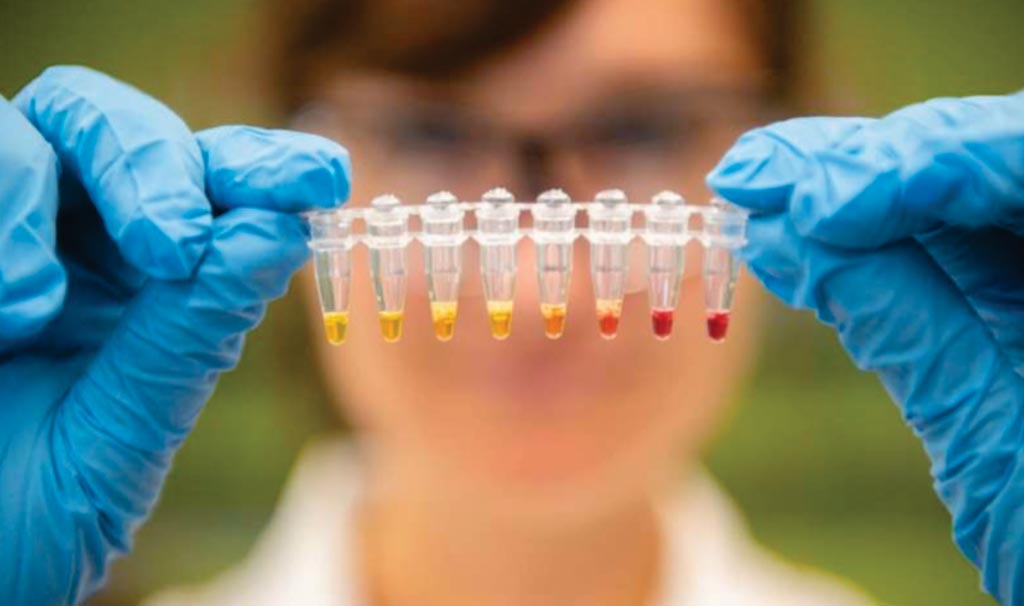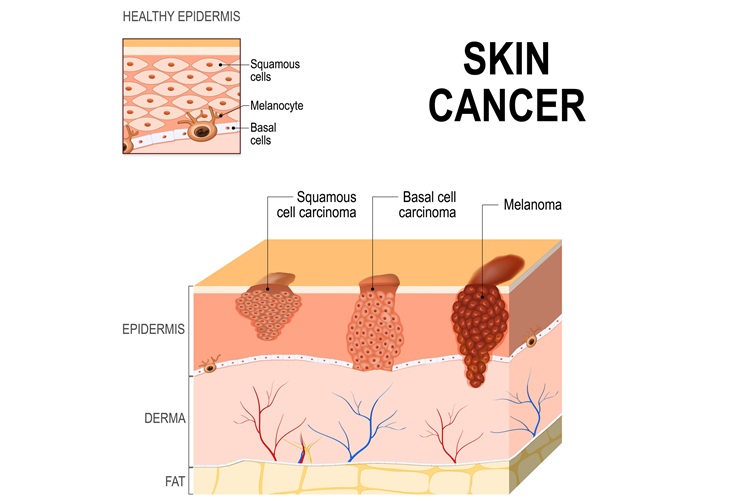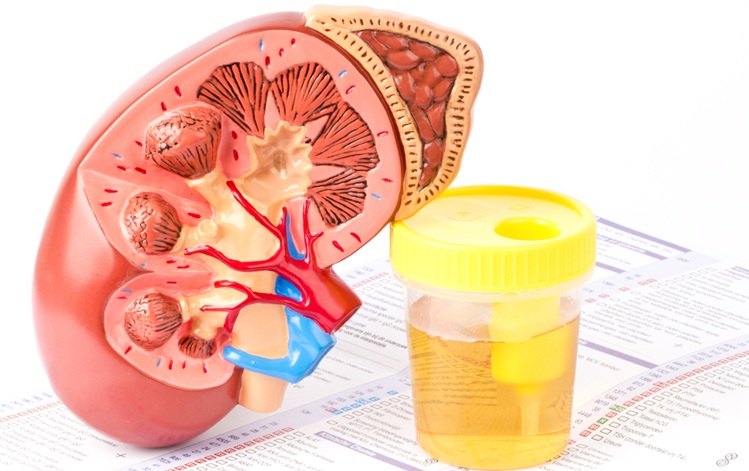Pocket-Sized Zinc Deficiency Test Evaluated
|
By LabMedica International staff writers Posted on 09 Oct 2019 |

Image: Scientists have developed a test that detects deadly zinc deficiencies in a single drop of the blood. The test could be made compact enough so that many fit in an aid worker’s pocket. It could help expose broad malnutrition in crisis regions (Photo courtesy of Georgia Institute of Technology).
Easy-to-perform, relatively inexpensive blood diagnostics have transformed at-home healthcare for some patients, but they require analytical equipment and are not easily adapted to measuring other biomarkers.
The requirement for reliable quantification in complex sample types, such as blood, has been a critical roadblock in developing and deploying inexpensive, minimal-equipment diagnostics. A pocket-sized zinc deficiency test has been developed that could be taken to remote regions where masses are malnourished with no complex transport or preservation necessary.
A team of scientists working with the Georgia Institute of Technology (Atlanta, GA, USA) developed a platform for inexpensive, easy-to-use diagnostics that uses cell-free expression to generate colored readouts that are visible to the naked eye, yet quantitative and robust to the interference effects seen in complex samples. The platform includes plasmids, which are loops of DNA. They are not the same DNA strands behind reproduction and cell construction, but function instead like nano-organs with genetic programs that normally guide bacterial cell processes. The team engineered their own plasmids to direct other parts extracted from bacteria to make the blood test work.
The test uses a signal molecule that is partly a big sugar and starts out yellow, but once the plasmid makes an enzyme that cleaves the sugar, the molecule turns purple. Zinc levels regulate how much enzyme is made more zinc means more enzyme and more purple. If the test remains yellow, zinc is perilously low. The new technology showed high potential as a basis for an inexpensive, easy malnutrition test for use in the field that could be expanded to include many vital nutrients and other health indicators.
The new test is freeze-dried to a powder that is kept at room temperatures, could be read in the field, and may be suitable for precise analysis with an applicable smartphone app. It could overcome the clinical and logistical travails of other tests, including refrigerated transport to the field or back to a laboratory, as well as lost time. The test not only detects zinc, but also quantifies its clinically relevant levels, which is necessary to detect malnourishment and is one of the new test's main innovations. Aid agencies could use a field version of the test to get immediate information to quickly influence policy decisions on nutritional interventions.
Mark P. Styczynski, PhD, an associate professor and first author of the study, said, “In the developing world today, many people may get enough calories but miss out on a lot of nutrients. You can look at someone and tell if they're getting enough calories but not if they're getting sufficient amounts of developmentally important nutrients. The impact is greatest on pregnant mothers, as well as children under the age of 5, which is when they have the highest mortality.” The study was published on September 4, 2019, in the journal Science Advances.
Related Links:
Georgia Institute of Technology
The requirement for reliable quantification in complex sample types, such as blood, has been a critical roadblock in developing and deploying inexpensive, minimal-equipment diagnostics. A pocket-sized zinc deficiency test has been developed that could be taken to remote regions where masses are malnourished with no complex transport or preservation necessary.
A team of scientists working with the Georgia Institute of Technology (Atlanta, GA, USA) developed a platform for inexpensive, easy-to-use diagnostics that uses cell-free expression to generate colored readouts that are visible to the naked eye, yet quantitative and robust to the interference effects seen in complex samples. The platform includes plasmids, which are loops of DNA. They are not the same DNA strands behind reproduction and cell construction, but function instead like nano-organs with genetic programs that normally guide bacterial cell processes. The team engineered their own plasmids to direct other parts extracted from bacteria to make the blood test work.
The test uses a signal molecule that is partly a big sugar and starts out yellow, but once the plasmid makes an enzyme that cleaves the sugar, the molecule turns purple. Zinc levels regulate how much enzyme is made more zinc means more enzyme and more purple. If the test remains yellow, zinc is perilously low. The new technology showed high potential as a basis for an inexpensive, easy malnutrition test for use in the field that could be expanded to include many vital nutrients and other health indicators.
The new test is freeze-dried to a powder that is kept at room temperatures, could be read in the field, and may be suitable for precise analysis with an applicable smartphone app. It could overcome the clinical and logistical travails of other tests, including refrigerated transport to the field or back to a laboratory, as well as lost time. The test not only detects zinc, but also quantifies its clinically relevant levels, which is necessary to detect malnourishment and is one of the new test's main innovations. Aid agencies could use a field version of the test to get immediate information to quickly influence policy decisions on nutritional interventions.
Mark P. Styczynski, PhD, an associate professor and first author of the study, said, “In the developing world today, many people may get enough calories but miss out on a lot of nutrients. You can look at someone and tell if they're getting enough calories but not if they're getting sufficient amounts of developmentally important nutrients. The impact is greatest on pregnant mothers, as well as children under the age of 5, which is when they have the highest mortality.” The study was published on September 4, 2019, in the journal Science Advances.
Related Links:
Georgia Institute of Technology
Latest Technology News
- Cell-Sorting Device Uses Electromagnetic Levitation to Precisely Direct Cell Movement

- Embedded GPU Platform Enables Rapid Blood Profiling for POC Diagnostics
- Viral Biosensor Test Simultaneously Detects Hepatitis and HIV
- Acoustofluidic Device to Transform Point-Of-Care sEV-Based Diagnostics
- AI Algorithm Assesses Progressive Decline in Kidney Function
- Taste-Based Influenza Test Could Replace Nasal Swabs with Chewing Gum
- 3D Micro-Printed Sensors to Advance On-Chip Biosensing for Early Disease Detection
- Hybrid Pipette Combines Manual Control with Fast Electronic Aliquoting
- Coral-Inspired Capsule Samples Hidden Bacteria from Small Intestine
- Rapid Diagnostic Technology Utilizes Breath Samples to Detect Lower Respiratory Tract Infections
Channels
Clinical Chemistry
view channel
VOCs Show Promise for Early Multi-Cancer Detection
Early cancer detection is critical to improving survival rates, but most current screening methods focus on individual cancer types and often involve invasive procedures. This makes it difficult to identify... Read more
Portable Raman Spectroscopy Offers Cost-Effective Kidney Disease Diagnosis at POC
Kidney disease is typically diagnosed through blood or urine tests, often when patients present with symptoms such as blood in urine, shortness of breath, or weight loss. While these tests are common,... Read moreMolecular Diagnostics
view channel
Urine Test Detects Early Stage Pancreatic Cancer
Pancreatic cancer remains among the hardest cancers to detect early. In the UK, around 10,000 people are diagnosed each year, but only 5% survive beyond five years. Late diagnosis is a major factor—more... Read more
Genomic Test Could Reduce Lymph Node Biopsy Surgery in Melanoma Patients
Accurately determining whether melanoma has spread to the lymph nodes is crucial for guiding treatment decisions, yet the standard procedure—sentinel lymph node biopsy—remains invasive, costly, and unnecessary... Read moreHematology
view channel
Viscoelastic Testing Could Improve Treatment of Maternal Hemorrhage
Postpartum hemorrhage, severe bleeding after childbirth, remains one of the leading causes of maternal mortality worldwide, yet many of these deaths are preventable. Standard care can be hindered by delays... Read more
Pioneering Model Measures Radiation Exposure in Blood for Precise Cancer Treatments
Scientists have long focused on protecting organs near tumors during radiotherapy, but blood — a vital, circulating tissue — has largely been excluded from dose calculations. Each blood cell passing through... Read more
Platelets Could Improve Early and Minimally Invasive Detection of Cancer
Platelets are widely recognized for their role in blood clotting and scab formation, but they also play a crucial role in immune defense by detecting pathogens and recruiting immune cells.... Read more
Portable and Disposable Device Obtains Platelet-Rich Plasma Without Complex Equipment
Platelet-rich plasma (PRP) plays a crucial role in regenerative medicine due to its ability to accelerate healing and repair tissue. However, obtaining PRP traditionally requires expensive centrifugation... Read moreImmunology
view channel
Blood-Based Liquid Biopsy Model Analyzes Immunotherapy Effectiveness
Immunotherapy has revolutionized cancer care by harnessing the immune system to fight tumors, yet predicting who will benefit remains a major challenge. Many patients undergo costly and taxing treatment... Read more
Signature Genes Predict T-Cell Expansion in Cancer Immunotherapy
Modern cancer immunotherapies rely on the ability of CD8⁺ T cells to rapidly multiply within tumors, generating the immune force needed to eliminate cancer cells. However, the biological triggers behind... Read moreMicrobiology
view channel
Fast Noninvasive Bedside Test Uses Sugar Fingerprint to Detect Fungal Infections
Candida bloodstream infections are a growing global health threat, causing an estimated 6 million cases and 3.8 million deaths annually. Hospitals are particularly vulnerable, as weakened patients after... Read more
Rapid Sepsis Diagnostic Device to Enable Personalized Critical Care for ICU Patients
Sepsis is a life-threatening condition that occurs when the body’s response to infection spirals out of control, damaging organs and leading to critical illness. Patients often arrive at intensive care... Read morePathology
view channel
New Molecular Analysis Tool to Improve Disease Diagnosis
Accurately distinguishing between similar biomolecules such as proteins is vital for biomedical research and diagnostics, yet existing analytical tools often fail to detect subtle structural or compositional... Read more
Tears Offer Noninvasive Alternative for Diagnosing Neurodegenerative Diseases
Diagnosing and monitoring eye and neurodegenerative diseases often requires invasive procedures to access ocular fluids. Ocular fluids like aqueous humor and vitreous humor contain valuable molecular information... Read moreIndustry
view channel
Puritan Medical Products Showcasing Innovation at AMP2025 in Boston
Puritan Medical Products (Guilford, ME, USA), the world’s most trusted manufacturer of swabs and specimen collection devices, is set to exhibit at AMP2025 in Boston, Massachusetts, from November 11–15.... Read more
Advanced Instruments Merged Under Nova Biomedical Name
Advanced Instruments (Norwood, MA, USA) and Nova Biomedical (Waltham, MA, USA) are now officially doing business under a single, unified brand. This transformation is expected to deliver greater value... Read more




















